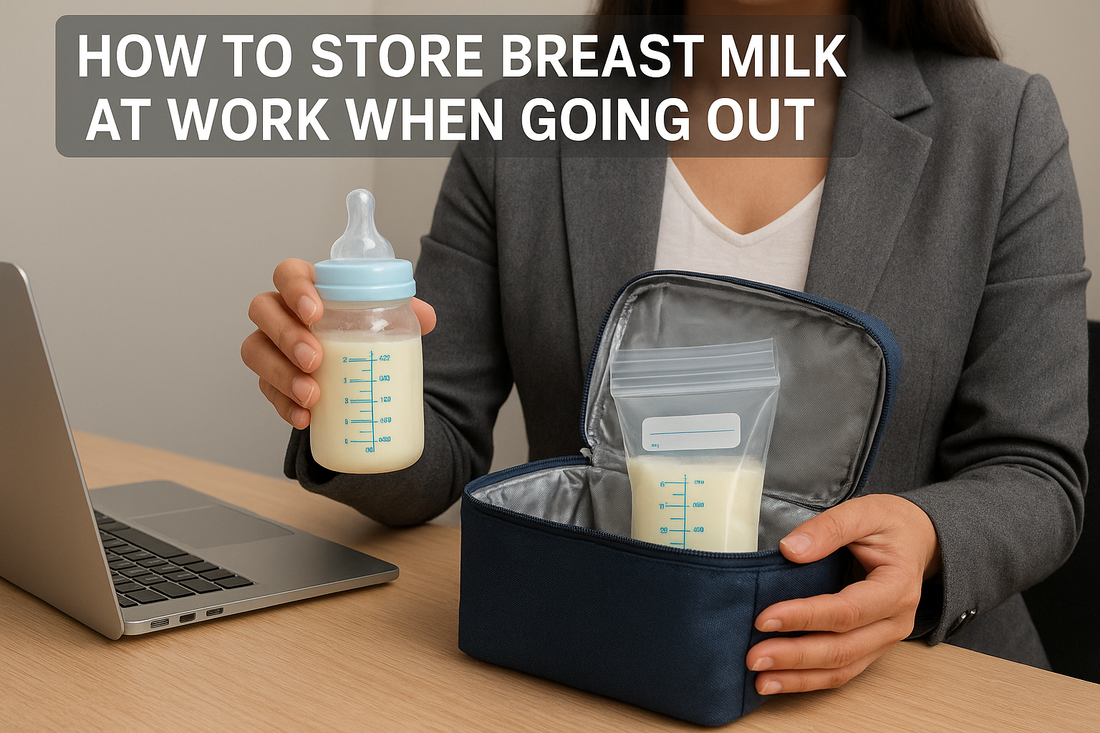
How to Store Breast Milk at Work When Going Out
Share
For many working moms, maintaining a steady milk supply while being away from their baby can feel challenging. Proper storage of breast milk at work ensures your baby continues to get the nutrients they need even when you’re not around. Whether you’re heading to the office, travelling for a meeting, or running errands, understanding the best ways to store and handle your expressed milk is essential for safety, convenience, and peace of mind.
In this guide, we’ll cover working moms’ milk storage tips, portable cooler solutions, travel milk storage methods, breastfeeding at work strategies, and how to organize a milk pumping schedule effectively.
Why Proper Milk Storage Matters
Breast milk is more than just food; it’s packed with antibodies, nutrients, and enzymes essential for your baby’s growth and immune system. Improper handling can reduce its nutritional value or lead to bacterial contamination. For working moms, understanding safe storage practices helps:
-
Preserve milk quality for longer periods
-
Avoid wastage of pumped milk
-
Keep your baby safe and healthy
-
Maintain your milk supply without stress
For detailed guidelines, you can check breast milk storage tips.
Planning Your Milk Pumping Schedule
A well-organized milk pumping schedule is essential for working moms to balance work responsibilities and breastfeeding successfully. Planning ensures your baby gets enough milk while helping you maintain a steady supply and avoid discomfort.
- Know your peak supply times: Many moms produce more milk in the morning. Try to pump at least once during these hours to maximize your output. Observing your body’s natural rhythm can help you schedule pumps efficiently and reduce stress during the workday.
- Set regular intervals: Aim to pump every 3–4 hours during your workday. Consistency helps prevent engorgement, keeps your milk supply steady, and makes it easier to store and plan feeds. You can adjust timing based on your baby’s feeding pattern and your comfort level.
- Plan for travel or long meetings: If you expect to be away from your usual pumping location for longer than your scheduled interval, prepare extra storage containers, ice packs, or portable coolers. This ensures that your milk stays safe and fresh until you return or have access to refrigeration.
- Keep a backup plan: It can be helpful to have a spare pump at work or in your travel bag. Also, having extra storage bags or bottles prevents delays if your primary containers are full.
- Label your milk: Always mark each container with the date and time of expression. Proper labeling allows you to use the oldest milk first, ensures freshness, and prevents accidental feeding of milk that has been stored too long.
Choosing the Right Containers
Selecting the right storage containers is crucial to maintaining milk quality and making pumping more convenient:
- BPA-free bottles: Use bottles specifically designed for breast milk storage. BPA-free containers prevent chemical leaching and preserve the natural nutrients in your milk.
- Freezer-safe bags: These are ideal for long-term storage and save space in fridges or coolers. Look for leak-proof and pre-sterilized options to make handling easier.
- Small portions: Store milk in 2–4 ounce amounts to minimize waste. Small portions also make thawing and feeding simpler, especially when you need milk on the go.
- Freeze-dried milk for convenience: For days when refrigeration isn’t available, consider using freeze-dried breast milk powder. It’s lightweight, easy to transport, and can be quickly reconstituted, making it perfect for travel or work trips.
Portable Coolers and Travel Milk Storage
Portable coolers are a lifesaver for working moms who need to store milk safely while on the move. Here’s how to use them effectively:
- Insulated coolers: Keep your milk cold for several hours. Include high-quality ice packs to maintain a temperature below 4°C (39°F), which is crucial for preventing bacterial growth.
- Organize efficiently: Use smaller containers and organize them in the cooler so that you don’t need to open it frequently. This prevents temperature fluctuations and keeps milk fresher for longer.
- Travel duration: Freshly expressed milk can safely remain in a cooler with ice packs for up to 24 hours. For longer trips, try to access a mini-fridge or freezer at your destination. Keeping extra ice packs or investing in a portable electric cooler can make extended travel easier and safer.
- Label and separate: Always label milk containers and separate milk from different pumping sessions. This helps maintain order, prevents mix-ups, and ensures your baby receives the oldest milk first.
- Tips for busy workdays: Consider storing your cooler in a dedicated space at work, such as a shared fridge or a private locker. You can also coordinate with your workplace to allow a small insulated fridge for milk storage.
Breastfeeding at Work: Tips and Strategies
Balancing work and breastfeeding requires careful planning, communication, and support from your workplace. With the right strategies, you can maintain your milk supply, keep your baby fed, and reduce stress while at work.
- Dedicated pumping space: Ask your employer for a clean, private space for expressing milk. This could be a lactation room, a small office, or even a quiet corner with a lockable door. Having a designated area helps you feel comfortable and ensures hygiene standards are maintained. Avoid using bathrooms for pumping, as they are not sanitary for milk expression.
- Flexible breaks: Schedule breaks around your pumping times to maintain your milk supply and avoid discomfort from engorgement. Most working moms find it helpful to pump every 3–4 hours, but you can adjust based on your baby’s feeding schedule. Planning your breaks helps you manage your workload without interruptions.
- Storage at work: Keep a mini-fridge or insulated cooler nearby if possible to store your milk safely until you head home. If refrigeration isn’t available, use ice packs in a well-insulated cooler to maintain a safe temperature. Consider keeping extra storage bags and containers at your workplace so you are always prepared for unexpected pumping sessions.
- Stay hydrated and nourished: Maintaining good hydration and nutrition is crucial for consistent milk production. Drink plenty of water throughout the day, and include lactation-friendly foods such as oats, nuts, and leafy greens in your meals and snacks. For more tips on boosting milk supply naturally, see food to increase breast milk.
- Communicate with your team: Inform your manager or HR about your breastfeeding needs. A supportive work environment makes it easier to take breaks, store milk, and manage pumping without stress. Many workplaces now provide lactation support programs, which can include private rooms, refrigeration access, or flexible scheduling.
- Organize your pumping kit: Keep a ready-to-go kit with your breast pump, spare parts, storage containers, cooler bag, ice packs, and sanitizing wipes. This ensures you are prepared for on-the-go pumping, reducing stress during busy workdays.
- Consider your clothing: Opt for clothes that make pumping easier, such as nursing tops or layered outfits. Comfortable and convenient clothing can make a big difference when trying to pump quickly during short breaks.
- Track your schedule: Use a small notebook or phone app to log pumping sessions, milk volume, and storage times. This helps you stay organized and ensures your baby receives milk that is fresh and safe.
By following these strategies, working moms can successfully continue breastfeeding while maintaining a professional routine. With planning and support, expressing and storing milk at work becomes manageable, allowing your baby to benefit from breast milk even when you are away.
Handling and Mixing Milk Batches
Sometimes, you may need to combine milk pumped at different times. Follow these steps to maintain quality:
-
Cool freshly expressed milk before mixing with refrigerated milk.
-
Combine gently to preserve nutrients and fat distribution.
-
Label with the oldest date to track storage limits.
Always avoid mixing fresh milk directly with frozen milk. For instructions on thawing frozen milk, see how to thaw frozen breast milk.
Tips for Keeping Milk Safe
-
Temperature control: Milk should never stay at room temperature for more than 4 hours. For longer periods, refrigerate or use a cooler.
-
Avoid repeated warming: Warm milk only once before feeding. Discard leftovers after feeding.
-
Hygiene: Wash hands before pumping or handling milk, and use sterilized containers.
- Monitor milk quality: Check for changes in smell or appearance before feeding.
Using Freeze-Dried Breast Milk Powder
Freeze-dried breast milk powder can be a convenient backup for working moms:
-
Safe for travel or long workdays when refrigeration isn’t available
-
Preserves nutrients from fresh milk
-
Easy to store in bags or small containers
-
Can be reconstituted with warm water when needed
Learn more about costs and benefits at freeze-dried breast milk cost.
Quick Checklist for Working Moms
-
Plan your milk pumping schedule
-
Bring sufficient storage containers
-
Use portable coolers with ice packs
-
Label all milk with date and time
-
Store milk properly at work or during travel
-
Warm milk only once and discard leftovers
Conclusion
Storing breast milk at work or while going out doesn’t have to be stressful. With careful planning, the right containers, and portable coolers, working moms can ensure their babies continue receiving safe, nutritious milk even when away. A consistent pumping schedule, proper storage, and hygiene practices make it easier to balance work and breastfeeding.
Whether you’re using fresh milk, combining batches, or exploring freeze-dried options, knowing the best methods for travel and storage helps maintain your milk supply and gives you peace of mind.
Frequently Asked Questions
-
Can I store breast milk at room temperature at work?
Freshly expressed milk can stay at room temperature for up to 4 hours. For longer periods, refrigerate or use a cooler with ice packs.
-
How do I transport breast milk safely during a commute?
Use insulated coolers with ice packs and small portioned containers to maintain cold temperatures and prevent spillage.
-
How often should I pump at work?
No, thawed milk should never be refrozen. Once it has been thawed, bacteria may have started to grow, and refreezing can compromise both safety and nutritional quality. Use thawed milk within 24 hours.
-
Can I mix milk from different workday?
No, only combine milk pumped within the same 24-hour period after cooling both batches to the same temperature.
-
Is it okay to use freeze-dried breast milk at work?
Yes, it’s a safe and convenient backup when refrigeration isn’t available. Simply reconstitute it with warm water before feeding..
-
How do I maintain milk supply while at work?
Stay hydrated, eat lactation-friendly foods, and stick to a consistent pumping schedule.
-
Can I store milk in a shared fridge at work?
Yes, but ensure your milk is sealed in labeled containers and placed in the coldest section of the fridge.
-
What is the best container for travel milk storage?
Use BPA-free bottles or freezer-safe storage bags, preferably in small portions for convenience..
